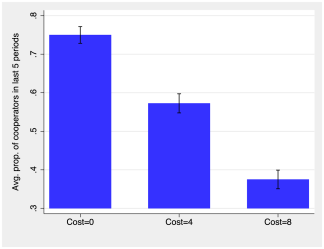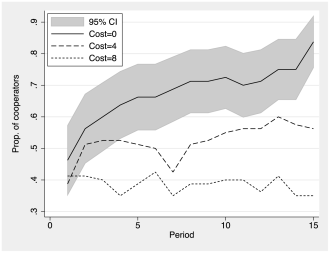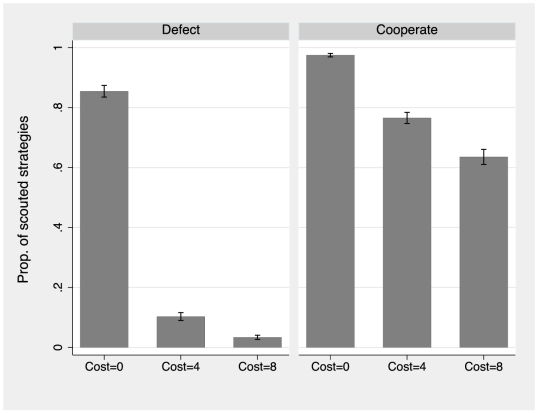This being the first post of Nectunt Blog, the companion blog to Nectunt, the website devoted to disseminate our research on cooperation, it feels only appropriate to touch upon one of the topics we have been scrutinizing more intensely: the role of networks on the promotion (or not) of cooperation. This line of research originates on a paper published by Martin Nowak and Robert May in 1992, in which they carried out numerical simulations showing that under certain circumstances cooperators could survive in a Prisoner’s Dilemma game played on a lattice. Our group has contributed very much to clarifying this issue with much theoretical and experimental work, and as you can see in our website, nowadays it is more or less clear that the fact that players play a Prisoner’s Dilemma only with their neighbors on a network does not in general help cooperation to prevail. However, a series of recent experimental works (e.g., this one or this one) have shown that, when the network of contacts can be arranged by the players, cooperation may indeed succeed. The rationale behind this result is rather intuitive: by cutting links with them, the population can in fact ostracize defectors, so players realize that only by cooperating (at least frequently) can they keep their connections and benefit from playing the game.
(Versión en español aquí)
It is clear that a key ingredient of such a cooperation-sustaining mechanism is information, i.e., knowledge on the previous actions (or a subset of them) of current neighbors as well as on neighbors-to-be. Players cannot react to defectors by cutting their links with them or connect to new cooperating neighbors if they don’t know whether they actually are cooperators or defectors. In the above mentioned experiments, information on a few previous rounds was available to the participants. But what happens if the information is not for free, and players have to pay for learning about their partners’ and possible partners’ actions? This is what Antonioni et al., at the University of Lausanne (Switzerland), set out to investigate in their recent work Know Thy Neighbor: Costly Information Can Hurt Cooperation in Dynamic Networks. To that end, they designed an experimental setup that goes as follows:
“In the first stage, players had to select one of two actions, “square” or “circle,” where “square” implied “cooperation” and “circle” implied “defection.” We chose to label actions in a neutral fashion to rule out framing effects. The association between the label (“circle” or “square”) and the actions (cooperation or defection) was randomized across sessions.
In the second stage, subjects received information on their own action and the number of current neighbors that selected each of the two actions. Subjects then chose one and only one of the following actions: do nothing at this stage, break a link with one of their current neighbors who chose “square,” break a link with one of their current neighbors who chose “circle,” or ask to be matched with a randomly chosen individual who is not yet their neighbor.
In the third stage, subjects saw how many individuals wanted to link with them (those who asked to be linked and were randomly assigned to the subject and his or her new partner if he or she asked for one). Subjects decided whether to pay a cost of per connection to be informed about the current action (“square” or “circle”) of each potential partner.
In the fourth stage, subjects saw the information they paid for and decided whether or not to accept each pending connection. Link deletion was unilateral. Link creation required mutual consent from both partners.”
The results were quite clear. As can be seen from the left panel in Figure 1 below, in the last periods about 75% of the participants in the experiment cooperate when information can be gathered for free; however, when information is costly, cooperation decreases, particularly so in the case when the cost is high (relatively to the game payoffs). On the other hand, looking at the evolution of cooperation in time in more detail (Figure 1, right), it can be seen that without costs, the behavior is similar to that observed in other experiments, whereas low costs lead to a non-increasing level of cooperation and high ones induce in fact a decrease of cooperation.
Figure 1. Left: Fraction of individuals cooperating during the last 5 periods by cost of obtaining information on new partner. Right: Fraction of cooperators by period and treatment (cost of information).
The authors study several other details of their experiment, including the so formed networks (average number of neighbors and overall structure) and the frequencies of the types of links (C-C, C-D and D-D) in the different conditions. Interestingly, they also observe that the total wealth of the network decreases with the cost of information, in agreement with the fact that there is less cooperation. But in my opinion one of their most interesting findings is contained in the figure below:
Figure 2. Fraction of scouted links among potential links by individual action and treatment (cost of information).
The authors use the word “scouting” to refer to the fact that players requested information on the action of the potential neighbors. As the figure shows, both defectors and cooperators scout when information is freely available; it would be ridiculous not to. However, for practical purposes, defectors cease to scout once information on the neighbor’s action becomes costly, while cooperators do continue scouting as information becomes costly, albeit at a lower rate than in the free-information treatment. This suggests that defectors have adopted the strategy “forget whom you are interacting with, accept everything and defect to reap the benefit” relying on being accepted by other players who do not pay for the information. The large amount of D-D links the authors find in the high cost treatment indeed points in this direction.
The final conclusion is therefore well sustained:
“Our results suggest that there is a cost barrier that depends on the actual payoffs, beyond which people have less propensity to pay for information, in spite of the fact that knowing the potential partner type improves decision making. We believe that these conditions are representative of many of today’s network relationships, in which a certain degree of anonymity can be maintained, and thus our results should be relevant in these contexts. As a consequence, cooperation is more difficult to achieve in situations in which costly or uncertain information about a partner’s behavior is the rule.”
More generally, this result points to the importance of considering not only the possibility to break links or make new one, but also the informational context in which this process takes place. We will be hearing more on this soon, from us and from others.
Original article: Antonioni A, Cacault MP, Lalive R, Tomassini M (2014) Know Thy Neighbor: Costly Information Can Hurt Cooperation in Dynamic Networks. PLoS ONE 9(10): e110788. doi:10.1371/journal.pone.0110788




Pingback: Sí, lo que hace que aparezca cooperación en redes dinámicas es la reputación | Nectunt Bitacora
Pingback: Yes, the driver of cooperation in dynamic networks is nothing but reputation | Nectunt Blog
Pingback: Isolating the effect of conditional dissociation on the emergence of cooperation. | Nectunt Blog